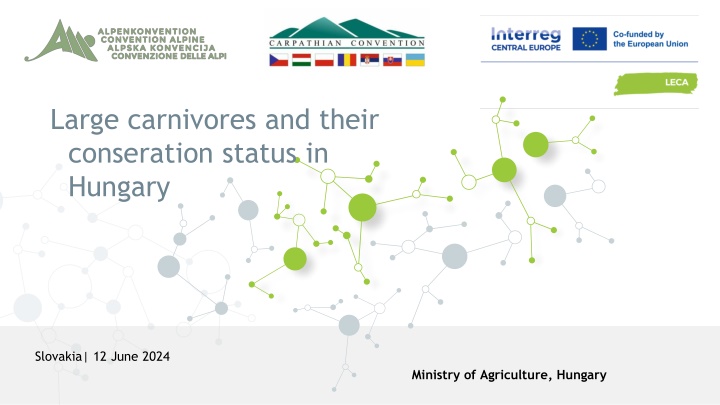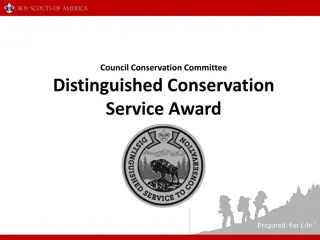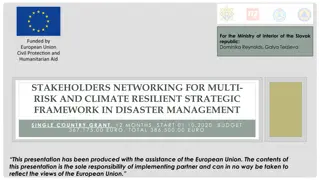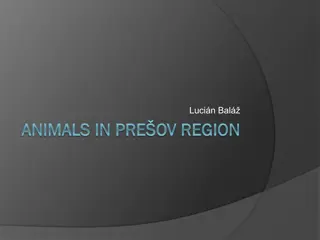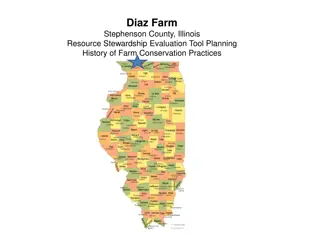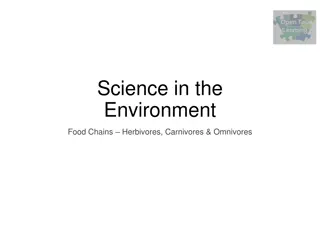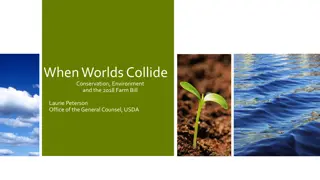Conservation Status of Large Carnivores in Hungary and Slovakia
Large carnivores such as wolves, lynx, and bears in Hungary and Slovakia are strictly protected under various national and international legislation. Conservation efforts include species conservation plans, conflict management, and habitat protection to ensure their populations thrive. The focus remains on monitoring, risk minimization, and habitat preservation to maintain a favorable conservation status.
Download Presentation

Please find below an Image/Link to download the presentation.
The content on the website is provided AS IS for your information and personal use only. It may not be sold, licensed, or shared on other websites without obtaining consent from the author.If you encounter any issues during the download, it is possible that the publisher has removed the file from their server.
You are allowed to download the files provided on this website for personal or commercial use, subject to the condition that they are used lawfully. All files are the property of their respective owners.
The content on the website is provided AS IS for your information and personal use only. It may not be sold, licensed, or shared on other websites without obtaining consent from the author.
E N D
Presentation Transcript
Large carnivores and their conseration status in Hungary Slovakia| 12 June 2024 Ministry of Agriculture, Hungary 1
Status of the species Wolf (40-60 individuals) and lynx (15-25 individuals): Bern Convention appendix: II. EU Habitat Directive annex: II. and IV. National legislation: strictly protected species (13/2001 ministerial decree) Bear (5-10 individuals): Bern Convention appendix: II. EU Habitat Directive annex: II. and IV. no Natura 2000 sites, no reporting National legislation: strictly protected species (13/2001 ministerial decree) 2
National legislation Act LIII. Of 1996 on Nature Conservation Ministerial Decree No.13/2001 (V.9.) on the Protected and Strictly Protected Species of Flora and Fauna Government Decree No. 348/2006 (XII.23.) about the Detailed Rules on Protection, Keeping, Display and Utilization of Protected Species Every activity regarding these species is strictly monitored and regulated by the nature conservation authority Strict permits can be issued for keeping and utilizing these animals Individuals of these species are only kept in zoos or other institutes data on origin cannot be captured in the wild to ensure the protection of the population 4
Species conservation plans Wolf: 1stconservation plan in 2004 and 2ndis under revision The goal is to support the spontaneous establishment of the species and the formation of a stable breeding stock and their protection Monitoring, protection and restoration of habitats, minimizing risk factors, conflict management Protection of known wolf dens e.g. restriction of forestry National park directorates and NGOs communicate with local stakeholders and the wider public Lynx: 1 conservation plan from 2004 Basically the same goals as with the wolf 5
Conflict management plan For the wolf and bear Issued by the Ministry of Agriculture in 2018 How to react, how to communicate, who is responsible for the conflict management action Problem animals can be removed from the population Made specifically because one bear crossed the whole country in 2018 The management plan needs revision Establishment of an expert coordination group is underway 6
Review of the implementation Conservation management didn t change in the last 10 years The goal is to reach the favorable conservation status of these species Focus is still on monitoring, habitat protection, risk minimization and damage prevention No derogations, no culling, no annual quota no active interference with large carnivore populations 7
Evaluation Population of large carnivores were slowly increasing in the last 10 years until recently observation and passive protection was enough More communication and cooperation is needed with (local) stakeholders The wolf population now appears to be in a decline (illegal hunting, roadkills) If populations continue to rise probably a more easily adaptable regulation and forward-thinking is needed regarding these conflicting species 8
Thank you for your attention! 9 www /daily-dew.com
